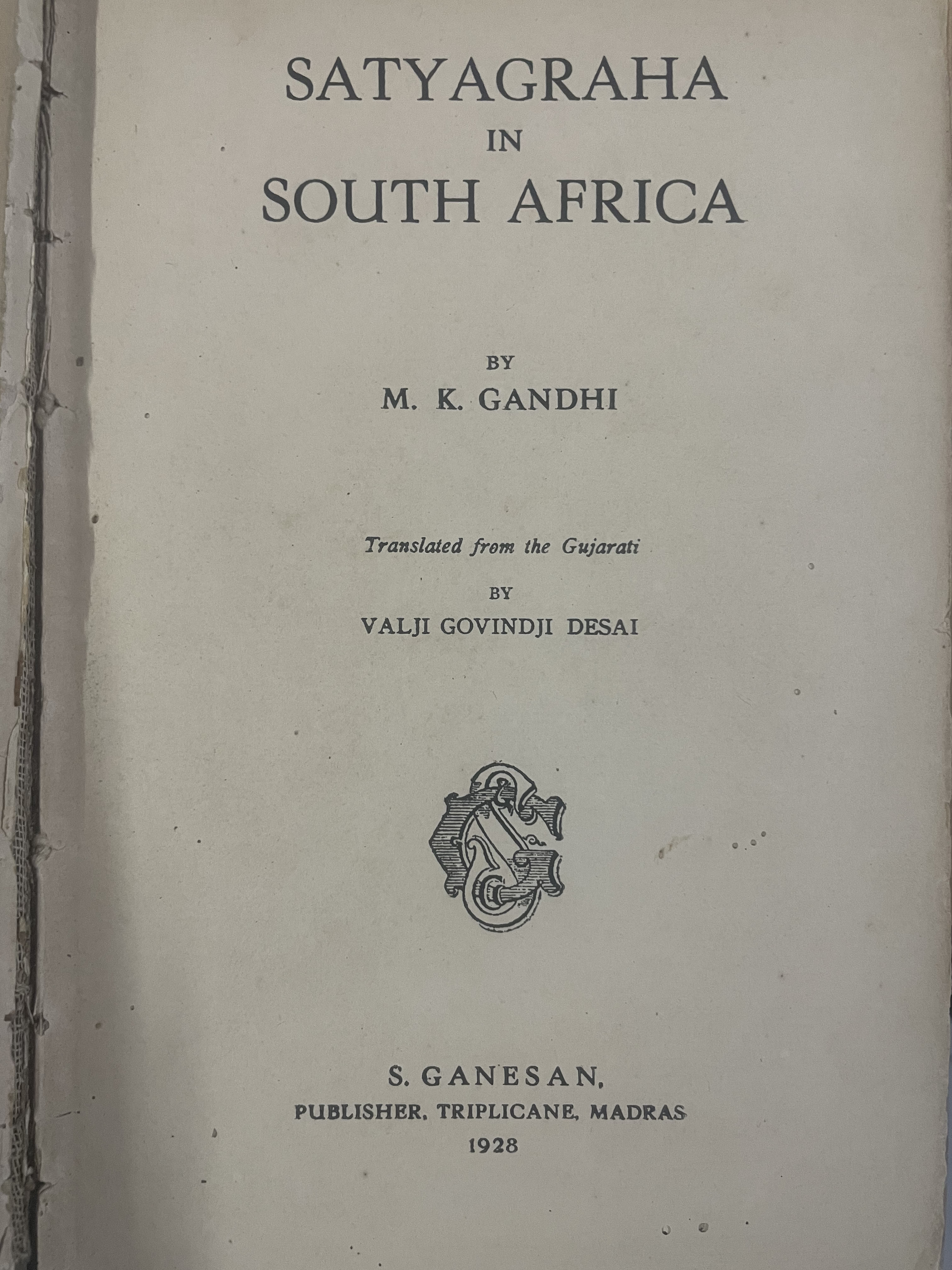Satyagraha in South Africa

About
Summary
Exquisite
TOC
Details
Related
URL
Images
Overview
Satyagraha in South Africa by M.K. Gandhi, initially published in India in 1928, recounts Gandhi's experiences and the evolution of Satyagraha, his philosophy of non-violent resistance, during his time in South Africa. The book details the historical events of the struggle against racial discrimination faced by Indians in South Africa and explains the core values and principles of Satyagraha.The book starts by describing South Africa's history and geography to contextualize the arrival of Indians and the circumstances leading to their grievances. Gandhi, then a young lawyer, had planned a short stay in South Africa for professional experience but became involved in the fight against discriminatory laws targeting Indian immigrants.
Importance of Book
Historical Record: Satyagraha in South Africa is a historical account of the struggle against racial discrimination faced by Indians in South Africa, providing insights into the social and political conditions and challenges faced by the Indian community.
Explanation of Satyagraha: The book explains Gandhi's philosophy of Satyagraha, detailing its principles, methods, and spirit.
Inspiration for Social Change: Satyagraha in South Africa has inspired movements for social change, demonstrating the power of non-violent resistance to overcome injustice.
Relevance to Contemporary Struggles: The principles of Satyagraha remain relevant to contemporary struggles for social justice, offering lessons for addressing issues through peaceful and ethical means.
Key Themes
The Development of Satyagraha: The book traces the evolution of Satyagraha as a philosophy and method of resistance. Gandhi explains its emergence from the South African struggle and its refinement over time.
Truth and Non-Violence: Satyagraha is based on truth (Satya) and non-violence (Ahimsa). Gandhi believed these principles were powerful forces to overcome injustice.
Courage and Self-Suffering: Satyagraha requires courage and willingness to endure suffering without retaliation. Gandhi argued self-suffering could awaken the oppressor's conscience and lead to change.
The Importance of Moral Purity: Gandhi stressed maintaining moral purity in pursuing justice, believing the means were as important as the end.
Sarvodaya (Welfare of All): Gandhi's goal was the welfare of all, including the oppressor, seeking a society based on justice, equality, and mutual respect.
Cultural Significance
Development of Gandhi's Leadership: Gandhi's experiences in South Africa shaped his leadership skills and his philosophy of Satyagraha, transforming him into a political leader and a moral force.
Impact on Indian Nationalism: Gandhi's work in South Africa contributed to Indian nationalism. His success in mobilizing the Indian community inspired nationalists in India and strengthened the demand for self-rule.
Influence on Civil Rights Movements: Gandhi's philosophy influenced civil rights movements, including the American Civil Rights Movement. His teachings on non-violent resistance provided a tool for challenging unjust laws.
Promotion of Interfaith Harmony: Gandhi opposed communalism and reached out to all religious groups, becoming a leader of Muslims protesting the declining status of the Caliphate and promoting religious and ethnic harmony.
Effects on Society
Empowerment of the Indian Community in South Africa: Gandhi's leadership empowered the Indian community in South Africa to fight for their rights, raising awareness of the discrimination they faced and leading to some improvements.
Inspiration for the Anti-Apartheid Movement: Gandhi's ideas inspired activists in the struggle against apartheid, providing a moral framework for the movement.
Influence on South African Law: The struggles led by Gandhi contributed to the repeal of discriminatory laws in South Africa, helping lay the foundation for a more just society.
Global Impact: Gandhi's philosophy has had a global impact, influencing movements for social justice and political change and continuing to inspire activists and leaders.
Conclusion
Satyagraha in South Africa is a vital text for understanding the origins and principles of Satyagraha and its lasting impact, offering lessons for creating positive social change through non-violent means and serving as a testament to the power of truth, courage, and compassion.
Table of Content
Satyagraha in South Africa\" by M.K. Gandhi, published in 1928, is a seminal account detailing Gandhi\'s experiences and the development of his nonviolent resistance movement, Satyagraha, during his time in South Africa from 1893 to 1914.Brief Overview:
Origins of Satyagraha: The book chronicles the genesis of Gandhi?s philosophy of Satyagraha, or \"truth force,\" which was conceived as a method of nonviolent resistance to injustice. Gandhi explains how his experiences in South Africa, particularly in confronting racial discrimination and unjust laws, shaped this approach.Key Campaigns: Gandhi describes several pivotal campaigns and struggles, including the fight against discriminatory legislation, such as the Asiatic Registration Act, and the efforts to secure civil rights for the Indian community in South Africa.Tolstoy Farm: The establishment of Tolstoy Farm, a communal settlement where Gandhi and his followers lived and practiced their principles, is detailed. This farm became a center for the movement and a practical example of Gandhi?s ideas in action.Community Response: The book highlights the response and involvement of the Indian community in South Africa, including how Gandhi mobilized them and the challenges they faced in their collective struggle.Negotiations and Outcomes: Gandhi discusses the negotiations with the South African government and the outcomes of the various campaigns. These negotiations often involved significant concessions from the authorities and marked important victories for the movement.Reflections: Gandhi reflects on the successes and shortcomings of the Satyagraha campaigns, offering insights into the principles of nonviolent resistance and its impact on his later work in India.Overall, \"Satyagraha in South Africa\" provides a detailed narrative of Gandhi?s early use of nonviolent resistance, offering valuable lessons on the efficacy and philosophy of Satyagraha that would later become central to the Indian independence movement.
Title
Satyagraha in South Africa
Author
M K Gandhi
Name of Publisher
S Gaeshan Triplicane Madras
Publish Date
1928
Subject
Gandhi\'s experiences and activities related to his nonviolent resistance movement
Vintage
1901-1947
Category
Gandhi
Sub Category
Biography
Rarity
RARE
